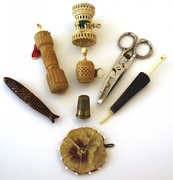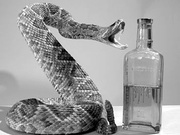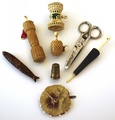
In present-day Silicon Valley, disruptive technology is the coin of the realm, no doubt because its business model is so simple: 1. Turn your competitors upside down. 2. Grab them by their ankles. 3. Shake vigorously until you are standing knee-deep in cash. Indeed, making money off other people’s ideas by identifying and developing an “unfair competitive advantage” has long been a sign of business acumen and ingenuity rather than mere charlatanry, even if the end products of such efforts are no more useful than a bottle of phony snake oil.
“They’re claiming to bring back people from the dead!”
The rich and colorful history of charlatanism and its somewhat more legitimate business cousins is showcased in a new book called Bizarre & Outlandish Gadgets & Doohickeys. Written by Maurice Collins and published by Schiffer, the 320-page volume is packed with the brainchildren of would-be disruptors who tried to make their fortunes between the years 1851 and 1951. Some clearly hoped to get rich quick at the expense of a credulous public, but others were guilty of nothing more than having a clever idea that once must have made sense but now seems quaintly out-of-date, usually because of its reliance on laughably archaic technology.

Top: The Memorandum Clock was used in lawyer’s offices, and perhaps houses of ill repute, to make sure a client does not overstay his welcome. Above: Thanks to a pair of mirrors in the eyepieces, Laying Down Glasses allow one to read a book while reclining, without even raising the book from one’s lap.
Collins got into these curious collectibles via parenting. “I have a severely learning disabled daughter named Kim,” he told me from his home in England when we spoke via Skype the other day. “When my son, Paul, was about 9, I realized I had been spending all of my time with Kim, who by then was 12 or 13. I wanted to spend more time with Paul, so I asked him what he wanted to do, anything at all. He said he wanted to go bottle-digging in rubbish dumps, and that’s when I started my collection.”
The fact that at least a few of the pieces in Collins’ collection were found in rubbish dumps should tell you something about the success of these relics as disruptive technologies, although, to be fair, most of the pieces Collins has amassed over the last 40 years have been purchased from antiques dealers.

The pistol secreted in this lady’s clutch was only powerful enough to frighten or wound a would-be assailant.
That’s certainly true of the Memorandum Clock, a handsome object from the late 1880s. “The photograph in the book doesn’t really do it justice,” Collins says of what appears to be a column-flanked mantel clock with a lidded kylix on top, all made out of fine hardwood. In fact, the photo at the top of this page is not in the book at all, but Collins agreed to share it with us since it reveals the interior of what is essentially a very elegant time clock.
“Let’s say you had an appointment with your solicitor,” Collins says, using the U.K. term for attorney. “You would go into his office and write your name on small piece of imitation ivory, probably bone. You’d place this time card in a slot, and at the end of your hour, the card would pop out the other end and a bell would ring. People say these were also used in houses of ill repute,” he adds. “Either way, at the end of your hour, you would have gotten screwed.”
Ba-da-bump.

The “Anita” Nose Adjuster promised to reshape one’s nose without surgery, which author Maurice Collins describes as “the ultimate in nasal quackery.”
The Memorandum Clock is not an especially disruptive piece of technology, unless, of course, you’re a customer in one of those houses of ill repute. It’s just a timepiece, you might say, whose time was up. For a better example of attempted disruption, as well as good old-fashioned charlatanism, Collins directs my attention to the “Anita” Nose Shaper, which, he tells me, was “the ultimate in nasal quackery.” The Memorandum Clock, he notes with some pride, is an English item. “This is American,” Collins says of the Nose Shaper, with just a trace of judgment in his voice.
According to an advertisement for the device, the cure for “nasal irregularity” is as easy as strapping on the nose adjuster before bed—“No need for costly, painful operations,” promises the advertising copy. In a few short weeks, your ugly nose will be as cute as a button. “What a con,” Collins huffs, “quackery to the Nth degree.”

The accompanying text claims a pinch of this Medicated Snuff can bring the drowned back from the dead.
Quackery to the Nth+1 degree resides on Page 31 of Gadgets & Doohickeys, which features an unassuming cylindrical jar from the mid-19th century and a flyer describing its contents, Medicated Snuff. Just a “few pinches” in the morning and evening, the flyer assures, “prevents or removes … every kind of stupification … smallpox, measles, putrid spotted fevers … deafness, swelling of glands, dimness of sight; and in cases of drowned persons, where the body has not been immersed in the water too long, if put into boiled vinegar, and rubbed with flannel about the nostrils, temples, belly, armpits, etc., will promote or affect a speedy recovery.”
“It’s just a timepiece, you might say, whose time was up.”
“They’re claiming to bring back people from the dead!”, Collins exclaims. “Now, that is the ultimate in quackery.” According to Collins, the bottle was sealed when he bought it and remains so today, which means the secrets of its magical contents could still be revealed to a grateful world.
Elsewhere in Gadgets & Doohickeys, Collins introduces us to a Victorian Ladies’ Gun Purse, which looks like a small clutch but has a hidden compartment in it for a small-calibre pistol designed to scare or wound an assailant but not powerful enough to kill. “This one was produced in Scotland, probably in the 1880s,” Collins says.

The barbs on this acorn-shaped pocket-watch fob were designed to catch on one’s clothing to foil the nefarious aims of would-be thieves.
Here in the States, weapons of this size are given away with Happy Meals, or so it seems, but in England, they take firearms of any sort seriously. “Recently, I put it in an exhibition,” Collins says, “but the police confiscated it because the bullet was still in it. The gun is only 3 or 4 inches long, and it was going into a museum, but the police took it anyway. I had to hire a gunsmith to sort it all out.”
A more benign protective device is the one on Page 305 that’s limited to Watch Security. Resembling a bass acorn, the device is designed to expose three steel barbs when one’s pocket watch is tugged upon by a would-be thief. As illustrated in his book, the gadget’s job appears to be to pierce the fingertips of the criminal, sending him fleeing in bloody and ignoble agony. In fact, Collins says, since the watch is in the owner’s pocket, all the barbs really need to do is catch on the owner’s clothes as it’s being pulled away. “I always thought it was designed to injure,” Collins admits, “but it wasn’t.”

This portable mustache protector could be retrieved from its case and affixed to a cup to prevent the hair on one’s upper lip from egregious stains.
Other objects are similarly civil. “In the Edwardian era, between 1901 and 1910, mustaches were the big thing,” Collins says. “There were plenty of mustache cups, and in the book I have an example of a mustache spoon, but there were also portable mustache protectors. Wherever you went, you could just slip your mustache protector from your pocket, put it on the end of your cup, and enjoy your cup of tea or cocoa without worrying about getting your mustache stained.”
A few pages later, Collins points out a pair of Laying Down Glasses, which allows the wearer to recline in bed and read without holding their book, which could be laid open and flat on the reader’s chest. “I’ve got two or three of those,” Collins says. “The earliest one, from about 1920, was made in Japan. I have a friend who used these glasses when he was in the hospital. They worked amazingly well.”

A compass hidden in an RAF crewman’s jacket button, circa World War II.
Even more potentially useful were the Escape Buttons, which were issued to British Royal Air Force crews during World War II. Such a button would look like a normal button on a military jacket, but inside was a miniature compass, which, Collins writes, gave a “downed aircrew a chance of finding their way to friendly territory. Sadly,” he adds, “if captured, the Germans would be on to this straightaway.”
In fact, Collins has several examples of secret compasses in Gadgets & Doohickeys. “There’s a razor blade that’s magnetized. You’d put it on some water and it would float due to the surface tension before turning north. There’s another compass that was designed to mimic the looks of a collar stiffener. I didn’t know about these things until about five years ago,” he adds, “and I’ve been collecting for 40 years.”

This Thumb-Sucking Stopper appears to be in good working order, save the rust.
That longevity has gained Collins quite a reputation locally. “I did a talk last night for charity—I do a lot of them, actually. As part of my talk, I always bring a box of perhaps 20 items. I spread them out on tables and ask people to guess what they are.” One of the items Collins had with him the night before we spoke was a Thumb-Sucking Stopper, which is one of those quintessentially bad Victorian Era ideas that exists only because an emerging technology—in this case, the ability to extrude wire—came along to make it possible. In the second half of the Victorian Era, wire-extruding technology was famously embraced by the barbed-wire industry, which needed a cheap and durable material to keep cattle at home on the range. That made sense, but the rust on one of the Thumb-Sucking Stoppers shows how ill-suited that same wire was to young, toothless tads.
Naturally, no one at Collins’s talk could figure out the use of such a nasty-looking device, but one older gentleman bravely ventured a guess. “He said, ‘It’s something to hold a man’s genitals in place.’ I said, ‘Excellent guess. Could you please come forward and show us how it would work?’”
Ba-da-bump.

This Clockwork Burglar Alarm from 1880 would be triggered when a door was opened, forcing the lever down and releasing a catch that set off a loud bell.
(Be sure to check out Bizarre & Outlandish Gadgets & Doohickeys by Maurice Collins. If you buy something through a link in this article, Collectors Weekly may get a share of the sale. Learn more.)

 How Snake Oil Got a Bad Rap (Hint: It Wasn't The Snakes' Fault)
How Snake Oil Got a Bad Rap (Hint: It Wasn't The Snakes' Fault)
 Royalty, Espionage, and Erotica: Secrets of the World's Tiniest Photographs
Royalty, Espionage, and Erotica: Secrets of the World's Tiniest Photographs How Snake Oil Got a Bad Rap (Hint: It Wasn't The Snakes' Fault)
How Snake Oil Got a Bad Rap (Hint: It Wasn't The Snakes' Fault) The Mystery of the Phantom Page Turner
The Mystery of the Phantom Page Turner Victorian EraThe Victorian Era, named after the prosperous and peaceful reign of England…
Victorian EraThe Victorian Era, named after the prosperous and peaceful reign of England… AdvertisingFrom colorful Victorian trade cards of the 1870s to the Super Bowl commerci…
AdvertisingFrom colorful Victorian trade cards of the 1870s to the Super Bowl commerci… Mari Tepper: Laying it on the Line
Mari Tepper: Laying it on the Line Nice Ice: Valerie Hammond on the Genteel Charm of Vintage Canadian Costume Jewelry
Nice Ice: Valerie Hammond on the Genteel Charm of Vintage Canadian Costume Jewelry How Jim Heimann Got Crazy for California Architecture
How Jim Heimann Got Crazy for California Architecture Modernist Man: Jock Peters May Be the Most Influential Architect You've Never Heard Of
Modernist Man: Jock Peters May Be the Most Influential Architect You've Never Heard Of Meet Cute: Were Kokeshi Dolls the Models for Hello Kitty, Pokemon, and Be@rbrick?
Meet Cute: Were Kokeshi Dolls the Models for Hello Kitty, Pokemon, and Be@rbrick? When the King of Comedy Posters Set His Surreal Sights on the World of Rock 'n' Roll
When the King of Comedy Posters Set His Surreal Sights on the World of Rock 'n' Roll How One Artist Makes New Art From Old Coloring Books and Found Photos
How One Artist Makes New Art From Old Coloring Books and Found Photos Say Cheese! How Bad Photography Has Changed Our Definition of Good Pictures
Say Cheese! How Bad Photography Has Changed Our Definition of Good Pictures Middle Earthenware: One Family's Quest to Reclaim Its Place in British Pottery History
Middle Earthenware: One Family's Quest to Reclaim Its Place in British Pottery History Fancy Fowl: How an Evil Sea Captain and a Beloved Queen Made the World Crave KFC
Fancy Fowl: How an Evil Sea Captain and a Beloved Queen Made the World Crave KFC
Leave a Comment or Ask a Question
If you want to identify an item, try posting it in our Show & Tell gallery.